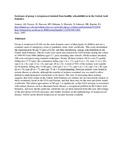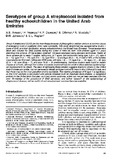| dc.description.abstract | Group A streptococci (GAS) are the most frequent cause of pharyngitis in children and are a common cause of emergency room or paediatric clinic visits worldwide. This study determined the representative M and T types of GAS, and their distribution, among schoolchildren in the United Arab Emirates. Throat swabs were taken and cultured for GAS isolates during the winter of 1994-95 from 1000 children aged 5-7 years attending nine schools. Of the isolates obtained, 100 were serotyped using standard techniques. Nearly all these isolates (91%) were T typable, falling into 15 T types; the commonest being type 1 (n = 17), type 6 (n = 15), type 11 (n = 10), type 2 (n = 8), type 12 (n = 8), and type 28 (n = 8). A total of 76% of the isolates were typable for M protein, falling into 14 M types, with type 1 (n = 17), type 6 (n = 15), type 2 (n = 8), type 22 (n = 5), type 28 (n = 7), and type 75 (n = 5) predominating. Serotype clusters were found in certain classes or schools, although the number of isolates examined was too small to allow definitive epidemiological conclusions to be drawn. The ease of serotyping these isolates suggests that GAS strains in the United Arab Emirates are similar, but not necessarily related, to those commonly found in the USA and Europe, and that these may be the most prevalent strains worldwide. The relative prevalence of M type 1 is significant, as this GAS serotype is associated with serious diseases such as rheumatic heart disease, a recognized problem in the United Arab Emirates, and toxic shock syndrome, which has not yet been reported from this area. Knowledge of the prevalence of GAS serotypes, and further research on the epidemiology of streptococcal disease, will be useful should streptococcal vaccines become available. | en |


